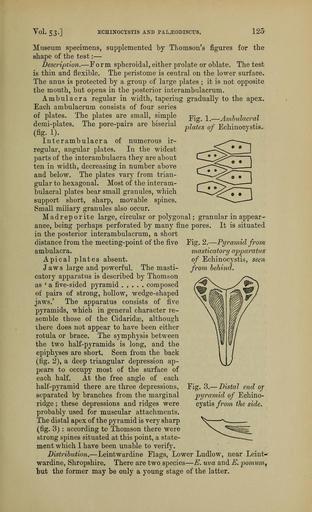MAKE A MEME
View Large Image

| View Original: | The_Quarterly_journal_of_the_Geological_Society_of_London_(12893481983).jpg (1232x2021) | |||
| Download: | Original | Medium | Small | Thumb |
| Courtesy of: | commons.wikimedia.org | More Like This | ||
| Keywords: The Quarterly journal of the Geological Society of London (12893481983).jpg Form spheroidal either prolate or oblate The test <br> is thin and flexible The peristome is central on the lower surface <br> The anus is protected by a group of large plates ; it is not opposite <br> the mouth but opens in the posterior inter ambulacrum <br> Ambulacra regular in width tapering gradually to the apex <br> Each ambulacrum consists of four series <br> of plates The plates are small simple <br> demi-plates The pore-pairs are biserial <br> ˘ i <br> Interambulacra of numerous ir- <br> regular angular plates In the widest <br> parts of the interambulacra they are about <br> ten in width decreasing in number above <br> and below The plates vary from trian- <br> gular to hexagonal Most of the interam- <br> bulacra plates bear small granules which <br> support short sharp movable spines <br> Small miliary granules also occur <br> M ad rep o rite large circular or polygonal; granular in appear -- <br> ance being perhaps perforated by many fine pores It is situated <br> in the posterior interambulacrum a short <br> distance from the meeting-point of the five <br> ambulacra <br> Apical plates absent <br> Jaws large and powerful The masti- <br> catory apparatus is described by Thomson <br> as ' a five-sided pyramid composed <br> of pairs of strong hollow wedge-shaped <br> jaws ' The apparatus consists of five <br> pyramids which in general character re- <br> semble those of the Cidaridse although <br> there does not appear to have been either <br> rotula or brace The symphysis between <br> the two half-pyramids is long and the <br> epiphyses are short Seen from the back <br> fig 2 a deep triangular depression ap- <br> pears to occupy most of the surface of <br> each half At the free angle of each <br> half-pyramid there are three depressions <br> separated by branches from the marginal <br> ridge ; these depressions and ridges were <br> probably used for muscular attachments <br> The distal apex of the pyramid is very sharp <br> fig 3 according to Thomson there were <br> strong spines situated at this point a state- <br> ment which I have been unable to verify <br> Distribution Leintwardine Flags Lower Ludlow near Leiut-- <br> wardine Shropshire There are two species E uva and E pomum <br> but the former may be only a young stage of the latter <br> Fig 2 Pyramid from <br> masticatory apparatus <br> of Echinocystis seen <br> from behind <br> Fig 3 Distal end of <br> pyramid of Echino- <br> cystis from the side 36028870 111130 51125 Page 125 Text 53 http //www biodiversitylibrary org/page/36028870 1897 Geological Society of London NameFound Echinocystis NameConfirmed Echinocystis Torr A Gray EOLID 71340 NameFound Echinocystis pomum NameConfirmed Echinocystis pomum NameFound Echinocystis uva Biodiversity Heritage Library The Quarterly journal of the Geological Society of London v 53 1897 Geology Periodicals Smithsonian Libraries bhl page 36028870 dc identifier http //biodiversitylibrary org/page/36028870 smithsonian libraries Information field Flickr posted date ISOdate 2014-03-03 Check categories 2015 August 26 CC-BY-2 0 BioDivLibrary https //flickr com/photos/61021753 N02/12893481983 2015-08-26 17 52 19 cc-by-2 0 PD-old-70-1923 The Quarterly journal of the Geological Society of London 1897 Photos uploaded from Flickr by FĂŚ using a script | ||||